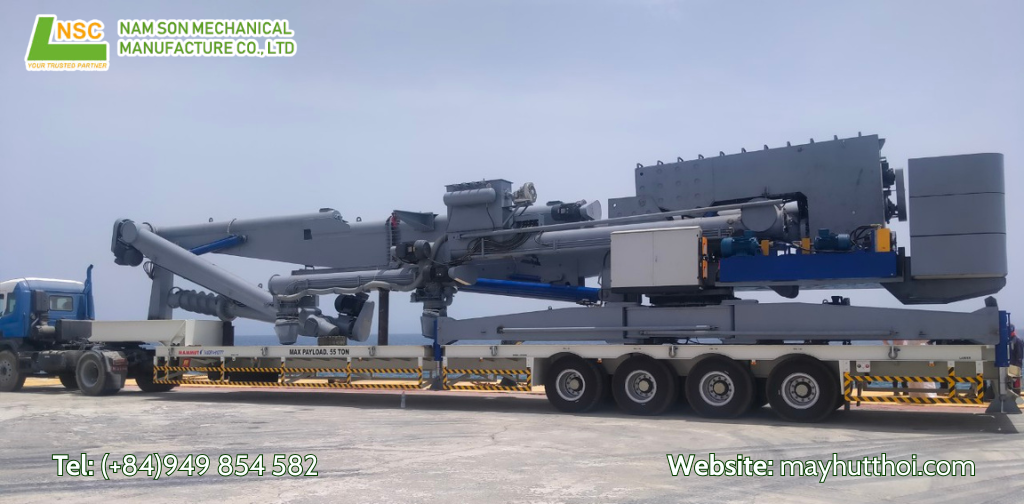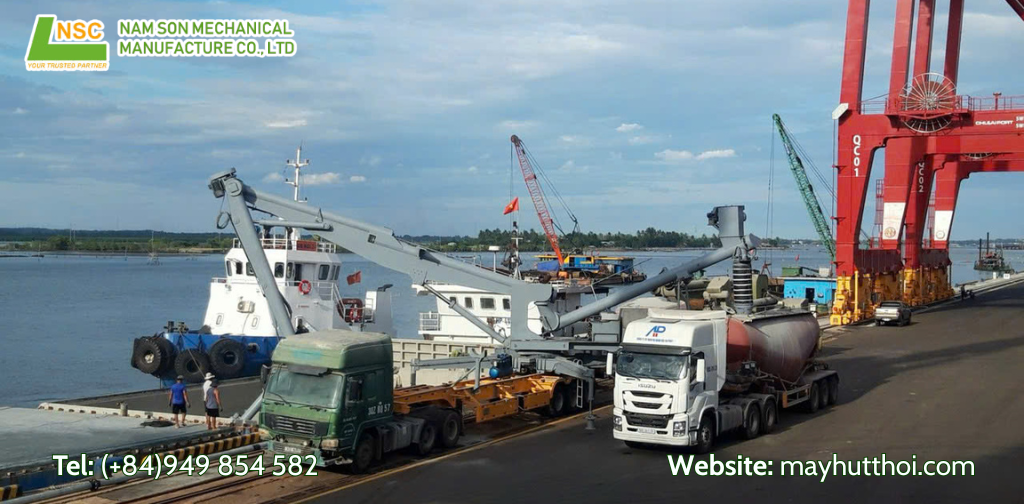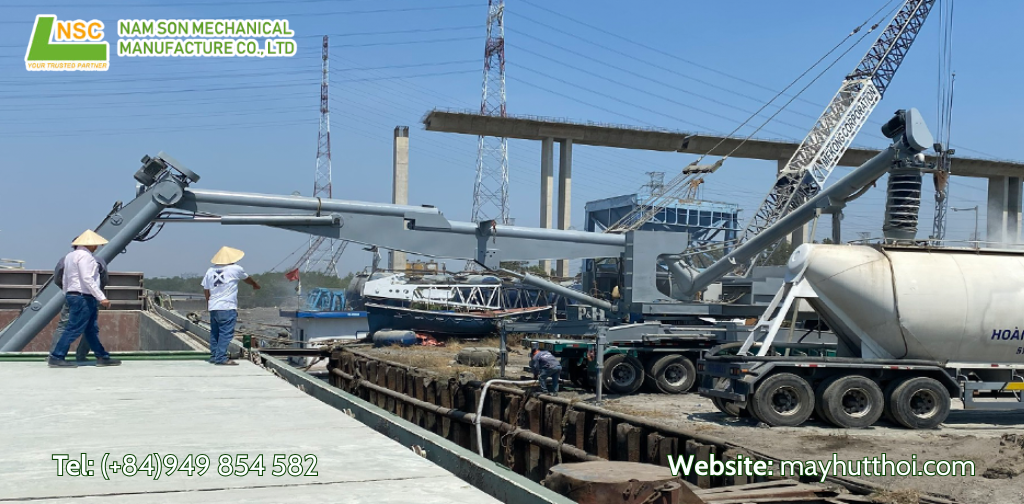


=>SEE MORE: Choosing the right cement ship unloading system in Vietnam

| Criteria | Mobile ship unloader | Fixed system |
| Installation | Plug-and-play, minimal foundation | Requires heavy civil works |
| Flexibility | Can serve multiple terminals | Limited to one location |
| Maintenance | Easier, modular components | Complex and costly |
| Investment cost | Lower capital expenditure | High infrastructure cost |
| Energy use | Energy-efficient, optimized flow | Higher energy consumption |
| Throughput | 400–1200 tons/hour | High but less adaptable |
| Mobility | Road or rail movable | Stationary and fixed |
In short, mobile ship unloaders provide a smarter, more flexible solution for modern ports that require adaptability and operational cost reduction.
One of the greatest strengths of the mobile ship unloader is its unmatched mobility. Designed as a road mobile unloader or wheel-mounted unloader, it can be deployed across multiple berths or terminals with minimal setup.
Unlike fixed systems, which are tied to a single dock, mobile units enable multi-port operations—a critical advantage for operators handling seasonal cargo, such as grain, fertilizer, or biomass.
This flexible deployment minimizes idle time between vessels and allows ports to optimize their overall logistics chain. Mobile unloaders can even be transported by road or barge to different port facilities, providing rapid relocation when demand shifts.
A mobile ship unloading system does not require extensive civil engineering work. There’s no need for fixed towers, deep foundations, or long conveyor galleries, which are typical for stationary unloaders.
This advantage translates into a reduced capital cost and shorter commissioning time. For small and medium-sized ports or terminals with limited infrastructure budgets, the mobile unloader provides a plug-and-play solution that can be set up in days instead of months.
This low infrastructure requirement not only speeds up deployment but also reduces long-term maintenance and energy costs associated with fixed installations.
Modern mobile ship unloaders are built with energy efficiency in mind. Many models feature pneumatic conveying systems or screw conveyors enclosed within sealed pipes, ensuring a dust-free ship unloading process.
This enclosed conveyor system minimizes material spillage and air pollution, meeting stricter environmental regulations in modern ports. Additionally, the optimized flow path and energy-efficient motors lead to lower power consumption per ton handled compared to traditional fixed unloaders.
By reducing emissions, energy waste, and product loss, the mobile unloader not only benefits port operations but also contributes to a more sustainable bulk handling environment.
While fixed systems have long been known for high capacity, today’s mobile ship unloaders are closing that gap rapidly. Many units achieve unloading capacities between 400 and 1200 tons per hour, depending on material type and density.
Thanks to continuous flow technology, mobile bulk unloaders maintain steady discharge rates without frequent pauses for repositioning. The combination of automated boom adjustment and material flow optimization ensures smooth operations even with varying vessel sizes.
In real-world operations, this flexibility allows ports to handle multiple cargo types — such as grain, cement, or coal — using the same equipment, significantly improving throughput efficiency.
The modular design of the mobile ship unloader simplifies maintenance tasks. Components like filters, blowers, and screw conveyors can be accessed easily, reducing downtime during servicing.
With advanced automation and control systems, operators can monitor performance, detect wear, and adjust settings remotely. Remote monitoring reduces manual labor and enables predictive maintenance — something that’s difficult to implement on older fixed systems.
The result is minimal downtime, lower repair costs, and greater operational reliability throughout the equipment’s lifecycle.
A key efficiency factor is scalability. Mobile ship unloaders can be upgraded or expanded to handle larger volumes as the port grows. Whether increasing capacity, extending boom reach, or adding new conveyors, modular configurations make these systems future-proof.
This investment efficiency allows port operators to start small and scale up later, avoiding the heavy upfront costs typical of fixed unloader systems. For modern ports adapting to unpredictable global trade volumes, mobile ship unloaders offer the flexibility needed for sustainable growth.
When comparing mobile ship unloaders with fixed systems, the differences in operational value become clear. The mobile unloader excels in nearly every efficiency metric — from setup time and energy consumption to environmental performance and maintenance.
+ Flexibility: Can serve multiple berths and terminals with one unit.
+ Cost Efficiency: Requires less infrastructure and investment.
+ Energy Optimization: Lower power usage and dust-free operation.
+ Maintenance Advantage: Modular components simplify servicing.
+ Scalability: Easily expandable as operations grow.
In short, mobile ship unloaders deliver superior efficiency because they combine mobility, adaptability, and sustainability into one integrated system. They represent the evolution of port technology — from static infrastructure to dynamic, data-driven bulk handling.
=>SEE MORE: A beginner's guide to cement ship unloading systems
The global shipping industry is evolving fast, demanding faster, cleaner, and more adaptable bulk unloading solutions. Compared to traditional fixed systems, mobile ship unloaders clearly deliver better results in efficiency, flexibility, and environmental performance.
By reducing installation complexity, lowering energy use, and enhancing mobility, these systems redefine what “efficient port operations” mean in the 21st century.
As more ports transition toward modular mobile unloading technology, the mobile ship unloader stands out as the most efficient, cost-effective, and sustainable choice for modern bulk cargo handling.
Contact our engineering team today to discuss your project requirements, request a detailed quotation, or schedule a technical consultation. Let us help you design a smarter, more efficient unloading system for your port operations.
✱ Website: mayhutthoi.com| namsonco.com
✱ Alibaba:dthson.trustpass.alibaba.com
✱ Facebook: facebook.com/NamSonPneumaticConveyor
✱ Zalo/Whatsapp:(+84) 949854582
✱ Email: mailan@namsonco.com | thanhson@namsonco.com
Copyright © 2016 Nhuamisa